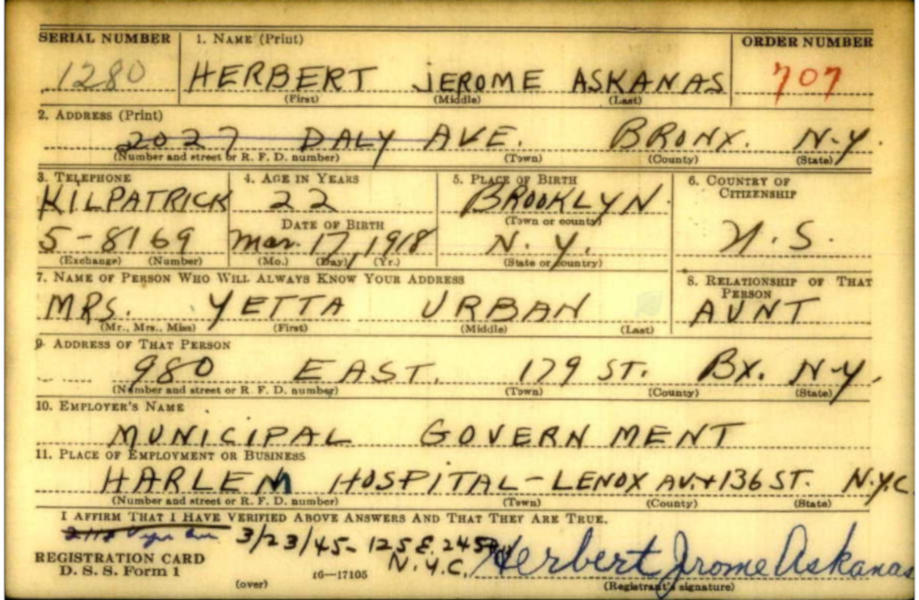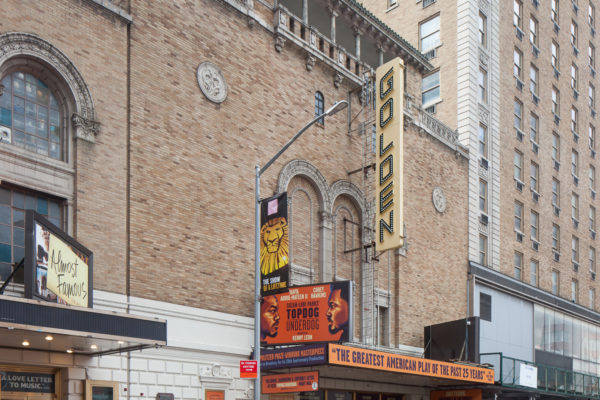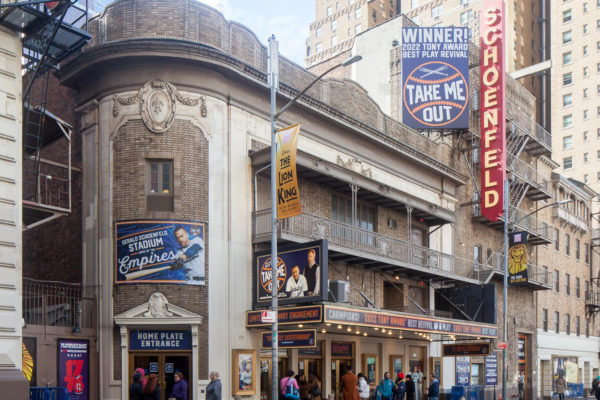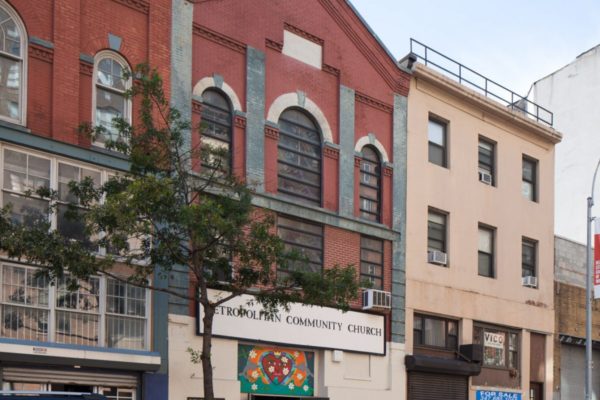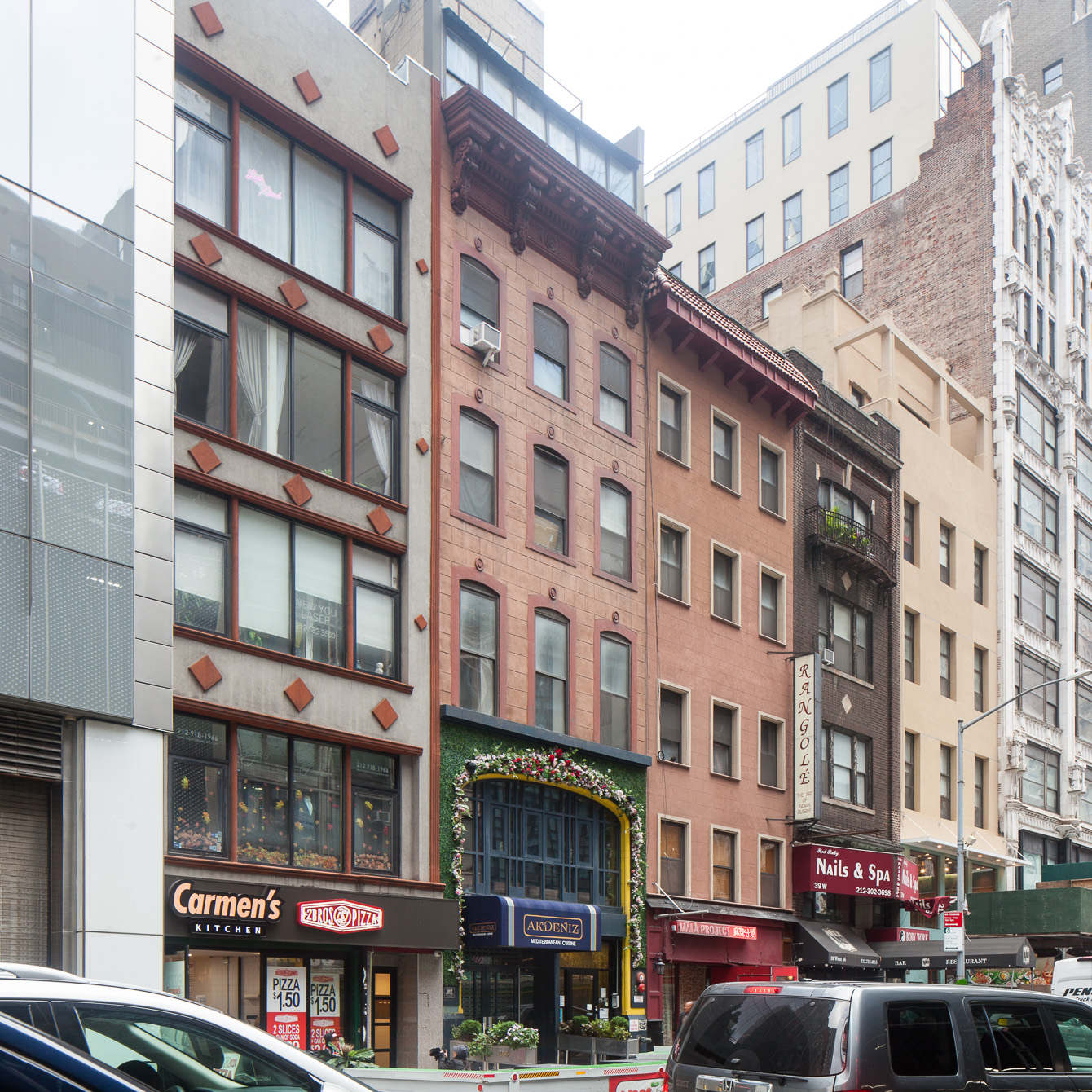
Herbert Askanas Residence
overview
The Veterans Benevolent Association was the first LGBT group formed in New York City, in 1945. Herbert Askanas, one of the original five directors of the group, was living in this Manhattan building when the VBA was incorporated in 1948.
For the two other directors whose residences still stand in New York City, see the Yale Eisenberg Residence in Brooklyn and the Irving Schwartz Residence in the Bronx.
On the Map
VIEW The Full MapHistory
The first American LGBT rights organization was the short-lived Society for Human Rights, founded in 1924 by the Bavarian-born Henry Gerber in Chicago. Two decades later, the first LGBT group in New York City was the Veterans Benevolent Association (VBA), formed in 1945. After thousands of gay and lesbian soldiers participated in World War II, many settled in New York with its large gay community. Four gay men who had received honorable discharges from the military started VBA, partly in response to many veterans getting less-than-honorable discharges because they were gay, and thus being denied the benefits of the G.I. Bill.
VBA was officially incorporated in New York State in 1948, making it undoubtedly the first LGBT group in the U.S. to do so. The incorporation papers, filed on March 8 (and approved March 12), noted that its main purpose was “to unite, socially and fraternally, all veterans and their friends, of good and moral character, over the age of twenty years.” One of the first five directors listed was Herbert Jerome Askanas, 43 West 46th Street, Manhattan. Online records have revealed some information about four of these men. Askanas (1918-2007), born in Brooklyn of German-Russian descent, was working as a clerk and at Harlem Hospital prior to enlisting in 1945.
The other directors were James Lang, 610 East 81st Street, Manhattan; Irving Schwartz, 1958 McGraw Avenue, Bronx; Yale Leonard Eisenberg, 10 Shore Boulevard, Brooklyn; and Albert Morris Mizrahi, 1204 Evergreen Avenue, Bronx. Schwartz (1924-1990), the son of Russian Jewish immigrants, was born in the Bronx and grew up in Monticello, NY, where he worked in a pharmacy prior to the war; he moved to Santa Barbara, CA, where he died. Eisenberg (1923-2012), born in Brooklyn of Hungarian-Russian descent, was working at the U.S. Government Printing Office in Washington, D.C., before the war; he died and was interred in Pompano Beach, Florida. Mizrahi (1921- ), born in New York City, was the son of Greek immigrants and was working as a bookbinder and stock clerk prior to enlisting in 1942 at Fort Jay, Governors Island. Also signing the incorporation papers were Henry F. Beecker, Melvin Fetterberg, Samuel Seigal, Robert Seigel, Henry Uhsmann, Irving Klapp, and Harry Helman.
As stated at the East Coast Homophile Organizations (ECHO) conference in 1965:
…the Veterans Benevolent Association…thrived for some seven or eight years. Although the emphasis was on social relations, on dances and picnics and outings, it nevertheless held lectures, had discussions, and constituted the first effort on the American scene for a group of homosexuals to meet quite openly.
Edward Sagarin was involved in VBA, and was one of the only members known to have written on the organization, in a dissertation in 1966. He had been the author (under the pseudonym Donald Webster Cory) of the pioneering The Homosexual in America (1951), one of the first works written by a homosexual describing discrimination faced by the gay community (he later became a quite controversial critic of the gay liberation movement). Jules Elphant talked about his experience as a young man with VBA in a recorded interview.
James Lang has been credited as the group’s main founder, and though married, doing the most to keep the organization functioning. VBA at first met monthly, then later every two weeks, on the fourth floor of a building located on Houston Street near Second Avenue (demolished). Membership consisted of about 75 to 100 men, apparently all white, with many Italian, Jewish, and Irish members. Aside from its lectures, discussions, and business meetings, VBA’s dances and parties could attract 400 to 500 people. VBA also had a legal advisory panel to assist its gay members and their friends who faced discrimination in areas such as arrest, employment, and housing. VBA is said to have joined with the NAACP to contest the disproportionate number of gay and Black veterans given discriminatory treatment in discharges and benefits.
In its later years, VBA members began to disagree about appropriate behavior at social gatherings and about the purpose of the group. Some wanted VBA to continue its low profile, while a faction wanted it to become more activist. VBA disbanded in 1954, and some members went on to form other gay rights groups.
Entry by Jay Shockley, project director (January 2022).
NOTE: Names above in bold indicate LGBT people.
Sources
Allan Berube, Coming Out Under Fire: the History of Gay Men and Women in World War Two (New York: The Free Press, 1990), 249.
Ancestry Library, records for Irving Schwartz, Herbert Askanas, Yale Eisenberg, and Albert Mizrahi.
Charles Kaiser, The Gay Metropolis, 1940-1996 (Boston: Houghton Mifflin, 1997), 51-52.
East Coast Homophile Organizations (ECHO), “The Homosexual Citizen in the Great Society” conference program, September 1965. [source of pull quote]
Edward Sagarin, “Structure and Ideology in an Association of Deviants,” Ph.D. dissertation, New York University, 1966.
John D’Emilio, Sexual Politics, Sexual Communities: the Making of a Homosexual Community in the United States, 1940-1970 (Chicago: University of Chicago Press, 1983), 32.
Jonathan Ned Katz, Gay American History: Lesbians and Gay Men in the U.S.A. (New York: Thomas Y. Crowell Co., 1976), 635.
Marvin Cutler, edit., Homosexuals Today: a Handbook of Organizations & Publications (Los Angeles: ONE. Inc., 1956), 89-90.
Stephen O. Murray, “Donald Webster Cory,” in Vern L. Bullough, edit., Before Stonewall: Activists for Lesbian and Gay Rights in Historical Context (New York: Harrington Park Press, 2002), 338.
Veterans Benevolent Association, “Certificate of Incorporation,” March 8, 1948.
Do you have more information about this site?
This project is enriched by your participation! Do you have your own images of this site? Or a story to share? Would you like to suggest a different historic site?
